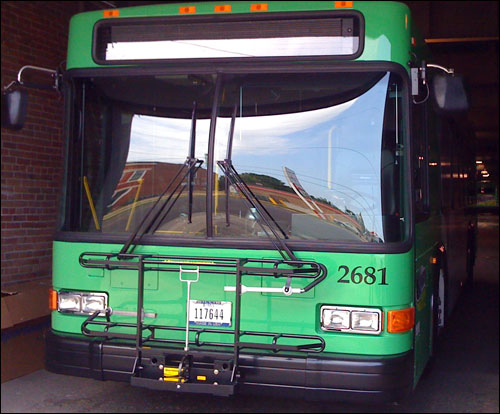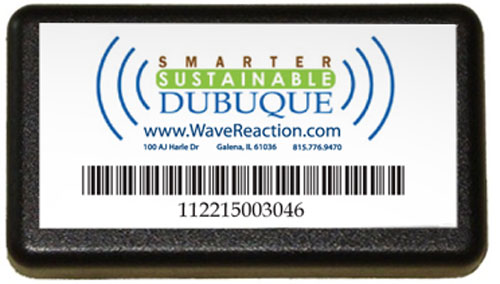Five hundred commuters in Dubuque, Iowa, are utilizing radio frequency identification tags that help the city track their movements, in an effort to improve the city’s public-transportation system. By carrying RFID tags onto the buses they ride, the volunteers are enabling the collection of data regarding when and where people get onto and off of buses. The results can then be shared with commuters (to help them plan their own transportation schedules, based on ridership information), as well as with the city’s transportation managers (to improve bus services).
The project employs RFID technology provided by Wave Reaction, based in Galena, Ill., and the ridership data is being analyzed by IBM Research. It is one of two projects being carried out during the city’s Smarter Travel Pilot Study, part of a larger effort known as Sustainable Dubuque, designed to improve everything from the city’s water service and power usage to health services. The other Smarter Travel project involves tracking the movements of commuters in their cars, via GPS data collected from cell phones. Both Smarter Travel initiatives are being undertaken by city volunteers. Neither project tracks the individuals by name, but simply by an anonymous ID number.

The Sustainable Dubuque endeavor commenced in 2006, says David Lyons, the project’s manager, when the city’s council and mayor established sustainability as its number-one priority. In 2009, Dubuque began planning pilot programs to learn more about how sustainable city services operate, and how they could be improved. With regard to transportation, the city hoped to obtain information that would help it determine how to encourage more bus ridership, as well as make bus scheduling more efficient (for example, ensuring that buses of the proper size travel the routes on which they are most needed). To accomplish this goal, the city began working with IBM Research to analyze data, and determined that RFID would be the best technology to acquire that information, by tracking ridership on its existing public-transit system. The portion of Dubuque’s public-transit system being used in this pilot consists of approximately 18 city buses, as well as several “on-demand” vehicles that are put into use in the event that heavy ridership requires extra service.
Each of the 18 buses—some small, and some full-sized, with two doors—were equipped with RFID readers designed and built by Wave Reaction. The company also installed a device known as a field generator on each bus, attached to the vehicle’s ceiling, according to Charles Daoud, Wave Reaction’s director of sales. The device consists of an antenna that acts as an exciter, sending a 433 MHz signal to that tag, thereby instructing it to beacon.
“Wave Reaction is a neat example of a local innovator who came in [and] explained the processes in a way that was faster and less expensive than we had expected,” Lyons says.
Each volunteer was provided with an active 433 MHz RFID tag compliant with the ISO 18000-7 standard. The tag, measuring about 1 inch by 2 inches, and a quarter-inch thick, fits into a user’s pocket or purse. To provide an incentive to carry the tag, the city is allowing the volunteers to receive free ridership if they present the tag to a driver upon entering a bus.
Each participant provided an e-mail address to receive updates regarding the study’s results. However, neither that address, nor any personal data, including that person’s name, is linked to the tag’s ID number. In that way, the information is kept completely anonymous.The tag beacons every five minutes. When a bus arrives at a stop, an individual can enter the vehicle, and the bus’ exciter instructs the rider’s tag to beacon once more. The reader captures the tag’s ID, emitting a beeping sound (for the benefit of both the tag user and the driver), in order to indicate that a tag was read. A GPS unit on the bus is also tracking the vehicle’s location. Both data points—the read event and the GPS location—are transmitted via a cellular connection to Wave Reaction’s server, where its software links the location data with the RFID read. The individual can then take a seat on the bus, and the tag will transmit its ID to the interrogator every five minutes, thereby indicating that the rider is still on the bus.
Upon exiting the bus, the rider passes the field generator at the doorway (on larger buses, the device is installed at each doorway), and the tag transmits again, indicating that the commuter is now at the door. Once he or she steps off the bus and the vehicle has continued on its route, the reader will receive no further transmissions from the tag, and the software can then determine where the individual debarked, by linking the GPS data and the read event.
IBM Research analyzes the read data and forwards that information to the city on a weekly basis, for further evaluation. The city can then make adjustments to bus route, based on the results. If ridership is especially high in certain areas and at particular times, for instance, an additional bus could be introduced to the route, whereas low ridership at other times could indicate that a smaller bus would suffice. The locations of bus stops could be changed as well, based on ridership data.
Passengers began utilizing the tags in mid-August 2011; the city has yet to begin viewing the results. The first few weeks of the pilot, Lyons says, were spent testing the system to determine how well the tag reads were being received. Several “dead zones”—locations at which cellular transmission was unreliable—were identified in that process, Daoud notes. In that case, the software was adjusted to recognize those spots, and to accommodate for the temporary cessation of transmissions.
Lyons says he hopes that Dubuque will be able to use the collected data to make bus service more convenient for riders, as well as increase sustainability, by ensuring that appropriately sized busses are scheduled at the proper time, in order to meet passengers’ needs. A large bus requires more fuel to operate than a smaller vehicle. Thus, if there are few passengers, a smaller bus could be more efficient and environmentally sustainable.
“For Dubuque, it isn’t just interesting data,” Lyons says. “It’s economic development.”


